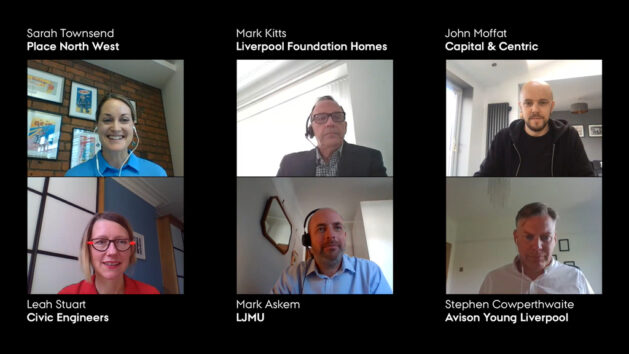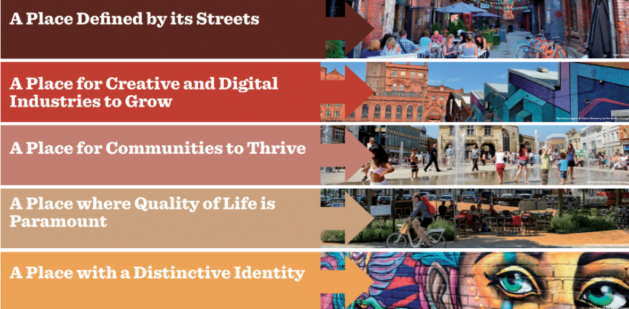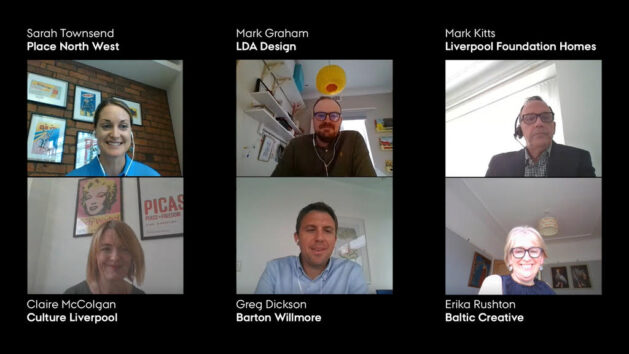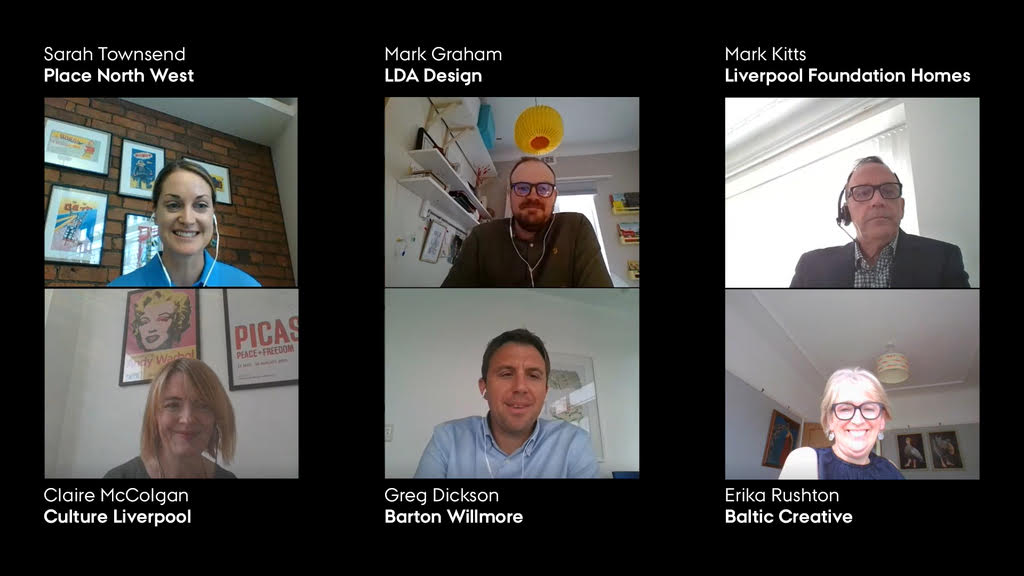Striking a balance between heritage and growth, and fostering greater collaboration between stakeholders and developers, will be key to Liverpool’s economic recovery and future development prospects, according to speakers at Place North West’s latest event.
The event was sponsored by Kier, Telcom, Lexington Communications, Satplan Planning and Development, and Caro Developments, and hosted by Place North West editor Sarah Townsend.
The line-up of high-profile speakers included representatives from developer Capital & Centric, consultancy Avison Young, landscape architect LDA Design, engineer Civic Engineers and Liverpool John Moores University, as well as Liverpool City Council’s newly formed housing delivery team, planning consultancy Barton Willmore, Baltic Creative and Culture Liverpool.

The event was the latest in a new Place North West conference format, using a platform called Remo that enables networking on digital ‘tables’, as well as many other features.
Ticketholders receive a copy of the video recording of the event. To buy access to the video for £25+VAT, email [email protected]
Key questions
- What does the future have in store for Liverpool’s development sector?
- How can Liverpool address reputational issues relating to the fractional sales model for high-density residential schemes, and a series of administrations and other controversial events in recent months?
- How can the city deliver developments that truly consider the needs of occupiers?
Main takeaways
- Liverpool is seeking to foster an approach of deeper consultation with communities to drive suitable and sustainable development
- The fractional sales model requires tougher regulation but the issue is not Liverpool’s alone
- A balance needs to be struck between preserving the city’s heritage and pushing ahead with economy-boosting development
Panel one – What’s in the pipeline for Liverpool?
John Moffat, developer, Capital & Centric
Mark Kitts, chief executive officer, Liverpool Foundation Homes
Leah Stuart, director, Civic Engineers
Stephen Cowperthwaite, principal and managing director, Avison Young Liverpool
Mark Askem, director of estate management, Liverpool John Moores University

John Moffat kicked off the event by providing an update on Capital & Centric’s £54m Littlewoods development, a 750,000 sq ft hub for the TV and film industry, the construction of which he said would start on site before the end of the year.
He added that securing its second tenant Liverpool John Moores University, which is to occupy 75,000 sq ft, was a “huge step forward”.
The TV and film industry is “booming” in Liverpool and Littlewoods could go some way to addressing a local skills shortage, according to Moffat.
“We are seeing a massive backlog in demand and we need more buildings in that sector to meet demand otherwise it would be a missed opportunity,” Moffat added.
Mark Kitts said that Liverpool City Council’s housing delivery programme had been brought in-house this year in response to a change in Government policy. He said the aim of the new Strategic Housing Delivery Team, which will replace arms length management organisation Liverpool Foundation Homes, is to meet the needs of the city’s “diverse housing market and bring strategy and delivery closer together”.
He added that he would like to see the introduction of regulation to govern the fractional sales model, including addressing the issue of funding into the planning process, but stressed that problems relating to risky fractional investments was not just a “Liverpool problem”.
“We want to be business-friendly and welcoming of investment, particularly now, but we have got to be wise to the fact that not all investment is good investment. We need to learn from the past,” he said.

Capital & Centric is developing the former Littlewoods Studios
Leah Stuart said Civic Engineers’ work on an overarching spatial strategy for Liverpool aims to reduce carbon emissions and make the city “happier and healthier”.
More work needs to be done to make Liverpool a more “equitable city”, as in the past, the design of transport and connectivity has been weighted in favour of commuters, she added.
“We need to start planning for women, the unemployed and people with caring responsibilities. We need to start planning for a more complex system to make it a fairer city,” Stuart said.
Stephen Cowperthwaite said that, while Liverpool has some reputational issues to overcome, the recent £12m investment in Sciontec from the Bruntwood SciTech joint venture between Legal & General and developer Bruntwood, shows confidence in what the city can offer.
“It is very important that we are attracting that kind of investment. There are plainly issues, but the more we can get good news stories the more we can change the dialogue in a positive way,” he said.
There has been a shift in occupier demand in the office market as a result of Covid-19 with many tenants seeking shorter leases and more flexibility, Cowperthwaite added.
He predicted that the average lease length, currently four years across the UK’s nine biggest cities, will continue to drop. “We need to see higher rents as a consequence,” he said.
Meanwhile, LJMU is looking to grow in several key areas including business, health and sports science, Mark Askem said.
The university has earmarked a site on the corner of Copperas Hill and Hawk Street for a 200,000 sq ft facility, of which half would be used as a business school and the remaining 100,000 sq ft given over to a commercial occupier.
Askem, who spoke of a “groundswell of positivity and collaboration” throughout Liverpool, said the university is now looking for a development partner for its pipeline schemes and wants to be on site early next year.
Getting creative in the Baltic Triangle

Mark Graham, director of landscape architect LDA Design, said the firm’s strategic regeneration framework for the Baltic Triangle, drawn up alongside JLL, Mott Macdonald, Authentic Futures and DS Emotion, focusses on five key objectives:
- Defining the area through streets
- Growing creative and digital industries
- Ensuring the area is built for communities
- Improving quality of life
- Creating a distinctive identity for the area
The overarching aim, Graham said, was to “create a framework that encouraged the right kind of growth in the area so that its future was sustainable”.
Reopening the St James Street station to improve connectivity from the city core, as well as identifying sites for residential development, such as on Flint Street South, are key features of the framework, he said.

Panel two – Where next for Liverpool’s Heritage regeneration?
Greg Dickson, director, Barton Willmore
Erika Rushton, creative economist, Baltic Creative
Claire McColgan, director, Culture Liverpool
Mark Graham, director, LDA Design
Mark Kitts, chief executive officer, Liverpool Foundation Homes

Mark Kitts said that the North Shore framework, a document drawn up by the council to guide development within Liverpool’s World Heritage Site, which he described as “one of Liverpool’s greatest regeneration opportunities”, is a “real statement of ambition”.
Developing on the former docklands is “very important” in terms of Liverpool’s economic recovery, Kitts added.
“The North Shore framework is an attempt to demonstrate to Unesco that the city needs growth and development but that the council wants to do that in a sustainable way with respect to heritage.”
Greg Dickson said the ‘People’s Project’ – Everton’s plan for a 53,000-capacity stadium at Bramley-Moore Dock, is “a signature project for the club and for the city”, which would “change and transform the local area”.
Various conservation bodies have opposed the scheme as it would involve the infilling of a dock that falls within the city’s World Heritage Site, but Dickson said the city should look to “grasp” the opportunity to bring forward the development.
“The waterfront has already changed a lot but we also have to recognise that the port-related activities that were the historic baseline for the city are long gone,” he said.

Erika Rushton admitted she was “not a fan of masterplans” and claimed that they restrict the ability to be “playful and creative” and that more attention should be given to the communities and businesses that inhabit an area.
“It is disappointing when I read a masterplan or framework and it is addressed to developers. Developers do the hardware but it is the people who fill those buildings and enable the development to be occupied,” she said.
Rushton was critical of Liverpool’s approach to development and urged a move away from the “notion of inward investment”.
“As we move forward, we have to think about what kind of world we want to live in and put our money there. We need to be radical and decide our direction of travel and think long term,” she said.
Claire McColgan spoke in support of retaining the city’s Unesco World Heritage status, claiming Liverpool is known internationally for its culture and people should stop “viewing heritage as a negative”. However, she also said this cultural heritage would remain intact even without the coveted status, which is currently under threat.
Collaboration between developers, artists and creatives is key for future development, McColgan added, citing the redevelopment of Princes Avenue as an example of this.
“We are creating a city for a next generation and the only way to do that well is to recognise that the most beautiful and impactful work that has happened in this city has put creative [people, businesses and communities] at its heart.
“When you take that away, you end up with developments that could be anywhere and that’s not right for Liverpool,” she said.

Conservation bodies have objected to Everton’s “harmful” plans
Mark Graham agreed with McColgan that heritage should not be viewed as a “restriction”.
“Heritage is an opportunity to be creative in terms of design response. In some places you get a homogenous design response but Liverpool is a great city and there is an opportunity to make it different and attractive to visitors and investors,” he said.
The proposed reopening of St James train station in the Baltic Triangle would provide increased accessibility to the area, Graham added.
“One of the key challenges [in the Baltic Triangle] is car parking, so providing sustainable public transport allows us to free up the streets. It isn’t fundamental to the future of area but it is an important step down the line,” he said.




More Stories
States, universities get $126 million for workforce development programs
MBA students teach incarcerated women career skills in new partnership
Electrical skills development boost for Antrim and Newtownabbey firms